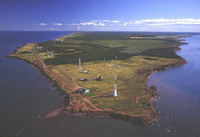Login form
Prince Edward Island
 Did you ever read the book Anne of Green Gables? It’s about the adventures and misadventures of an orphan named Anne Shirley. She lives on Prince Edward Island in the late 1800s. Her house, Green Gables, is in a village called Avonlea.
Did you ever read the book Anne of Green Gables? It’s about the adventures and misadventures of an orphan named Anne Shirley. She lives on Prince Edward Island in the late 1800s. Her house, Green Gables, is in a village called Avonlea.
ANNE’S LAND
Anne of Green Gables was written by Lucy Maud Montgomery. The real Green Gables was owned by relatives of the author. Green Gables is actually in Cavendish, a small farming community in the northern part of Prince Edward Island. Some people call this part of the island “Anne’s Land.”
|
Facts About Prince Edward Island |
|
|
|
|
|
Capital |
Charlottetown |
|
Population |
138,000 people |
|
Rank among provinces and territories in population |
10th |
|
Major cities |
Charlottetown, Summerside |
|
Area |
2,190 square miles |
|
Rank among provinces and territories in area |
13th |
|
Entry into federation |
July 1, 1873 |
|
Provincial bird |
Blue Jay |
|
Provincial flower |
Ladyâ€(tm)s Slipper |
|
Abbreviation |
PE |
Today the Green Gables farmhouse is a museum. It is part of Prince Edward Island National Park. Nearby is Avonlea Village, where you can see how Anne lived. Fans from all over the world come to see these sites. Other nearby attractions include Montgomery’s birthplace and the one-room schoolhouse where she taught.
A MARITIME PROVINCE
Prince Edward Island is the smallest province in Canada. From one end to the other, the island is only 140 miles (225 kilometers) long. Its width varies from 4 miles (6 kilometers) to 40 miles (64 kilometers), depending on where you are.
Prince Edward Island is one of Canada’s three Maritime Provinces, along with New Brunswick and Nova Scotia. Maritime means “close to the sea.” This island province is located in the Gulf of St. Lawrence, a large arm of the Atlantic Ocean.
Charlottetown is the capital of Prince Edward Island and its largest city. But Charlottetown is the smallest capital of any Canadian province.
Ferries have linked Prince Edward Island with the Canadian mainland for many years. In winter, the water in the gulf freezes, and ice-breaking ferries are needed to get through. In 1997, the Confederation Bridge opened between the island and New Brunswick. Cars can make the trip in less than 15 minutes on this bridge.
FISHING AND FARMING
Fishing is an important industry on Prince Edward Island. Lobster is the most valuable catch. Lobster is so popular that McDonald’s restaurants on the island offer a “McLobster” sandwich in summer!
About half of Prince Edward Island is farmland. Potato vines, golden grains, and green clover cover the farmland in summer. Wildflowers and small forests also dot the island.
Its fertile soil has earned the island many nicknames. They include the Garden of the Gulf, the Million-Acre Farm, and Spud Island. The last name pays tribute to the island’s potatoes. Their flavor is credited to the rich red soil on Prince Edward Island.
VACATION SPOT
Prince Edward Island is a popular vacation spot. Picturesque roads wind through its rural scenery. The roads never go far from the sea. The island has many golf courses.
Prince Edward Island National Park has sandy beaches for swimming in the Gulf of St. Lawrence. The park is in a scenic area of sandstone cliffs, grass-topped sand dunes, and salt marshes. The red sandstone gives the island its red soil. Rare orchids grow in the marshes.
WHAT’S IN A NAME?
Long before Europeans arrived, the island was home to Mi’kmaq Indians. They called the island Epekwitk, which means “cradled on the waves.”
French explorers called the island Île Saint Jean. British settlers translated that name to English, and it became Saint John’s Island.
The people of Saint John’s Island decided there were too many places named Saint John in the Maritime Provinces. In 1799, they decided to rename the island after Prince Edward, one of the sons of King George III of Britain. Charlottetown is named after Queen Charlotte, the wife of George III.
CANADA’S BIRTHPLACE
Prince Edward Island played a role in Canada’s founding. In 1864, officials from the Maritime Provinces and the province of Canada (Ontario and Québec) met in Charlottetown on Prince Edward Island. They discussed the possibility of uniting Britain’s North American provinces into one nation.
This meeting, called the Charlottetown Conference, marked the first steps toward creating the nation of Canada. The union of four provinces was finally achieved in 1867. Canadians call this union the Confederation. The original provinces in the Confederation were New Brunswick, Nova Scotia, Ontario, and Québec. On July 1, 1873, Prince Edward Island became the seventh province to join the Confederation.
Source: Microsoft ® Encarta

